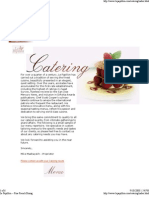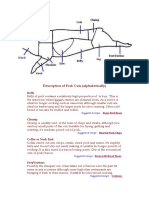Pizza Stone Care
Pizza Stone Care
Uploaded by
jackjensen2852Copyright:
Available Formats
Pizza Stone Care
Pizza Stone Care
Uploaded by
jackjensen2852Original Description:
Copyright
Available Formats
Share this document
Did you find this document useful?
Is this content inappropriate?
Copyright:
Available Formats
Pizza Stone Care
Pizza Stone Care
Uploaded by
jackjensen2852Copyright:
Available Formats
Advantages for
Flame Cookware
USAGE TIPS
EE
A new ceramic technology
for cooking in the oven
and on the grill
All types of ovens:
traditional, convection and
microwave safe.
All types of grills: gas,
charcoal and natural
wood.
Keeps hot longer
Easy to clean, and
dishwasher safe
Provides gentle, even heat
distribution; coaxes out
the natural flavors of food
and maintains natural
textures and colors, results
in better tasting dishes
Light, easy to handle - 30%
Lighter than Cast Iron
Can be heated to
extremely high
temperatures for searing
Manufactured in France
from Burgundy Clay and
other natural products
Two year warranty for
household use, against
RANT
manufacturers
UA
defects
2
YE
ARS
Homemade Pizza Preheat
the Pizza Stone and use a
pizza peel to place pizza on
the hot Pizza Stone on the grill
or in the oven.
Frozen Pizza Preheat the
oven and place the frozen
pizza onto the cold Pizza Stone.
Then place the Pizza Stone
with the Pizza directly into the
oven. Follow instructions on
the frozen pizza box.
Pizza Stone
Use and Care Instructions
The Pizza Stone is made of all natural materials and is
manufactured using Emile Henrys proprietary Flame
technology.
Designed for use:
In ovens - conventional and convection; and can also
be used under the broiler.
On grills - gas, charcoal and natural wood. The Pizza
Stone turns a grill into an outdoor pizza oven.
The Pizza Stone can withstand high oven temperatures.
CARE TIPS
Prevent breakage from
thermal shock by placing the
hot pizza stone on a cutting
board, hot plate or trivet
rather than a cold counter.
Avoid placing other pans or
racks on top of Pizza Stone
while baking.
Emile Henry U.S.A.
Customer Service
802 Centerpoint Blvd.
New Castle, DE 19720
(302) 326-4800
sales@emilehenryusa.com
The glaze is micro-crazed contributing to crispy wellbaked crusts, just like a pizza oven.
You can cut directly on the glazed pizza stone without
damaging or scratching the surface.
The Pizza Stone is easy to clean with soap and water and
is dishwasher safe.
The Pizza Stone is not recommended for use on the
stovetop.
Recipe provided by: Jeff Hertzberg, M.D. and Zo Franois, authors of Artisan Pizza and Flatbread in Five Minutes a Day. More information at PizzaIn5.com
www.redstaryeast.com
Not to
Exceed $1.99
3-Strip
Package
|
DO NOT DOUBLE
|
MANUFACTURERS COUPON
5. Prepare and measure toppings in advance: This will help you top the pizza quickly so you can get it into the oven before it sticks to
the pizza peel.
6. Thirty minutes before youre ready to bake, preheat an Emile Henry baking stone at your ovens highest temperature, with the baking
stone placed in the bottom third of the oven (consider a longer preheat if youre the crust is too soft).
7. Shape a ball in 20-30 seconds. First, prepare a pizza peel with flour, cornmeal or parchment to prevent your pizza from sticking to it
when you slide it in the oven. Sprinkle the surface of your refrigerated dough with flour. Pull up and cut off a 1/2 lb (orange-size) piece
of dough, using a serrated knife or kitchen shears. Hold the piece of dough in your hands and add a little more flour as needed so it
wont stick to your hands. Gently stretch the surface of the dough around to the bottom on all sides, rotating the dough a 1/4 turn as
you go to form a ball. Most of the dusting flour will fall off; its not intended to be incorporated into dough. The bottom of ball may
appear to be a collection of bunched ends, but it will flatten out and adhere when you roll it into a pizza/flatbread. The entire
process should take no longer than 20-30 seconds.
8. Roll out and stretch a pizza crust: Flatten the dough with your hands and a rolling pin on the counter or directly onto the pizza peel to
produce a -inch thick round, dusting with flour to keep the dough from adhering to your work surface. A little sticking to the surface
can be helpful in overcoming the doughs resistance to stretch. Use a dough scraper to un-stick the dough as needed, and
transfer it to the prepared pizza peel if you havent stretched the dough directly on one. When youre finished, the dough round will
be about 12 inches across, and should have enough flour under it to move easily when you shake the peel. As you add toppings,
continue to test for sticking by gently shaking the peel. The pizza should move freely. If it doesnt, use the dough scraper and some
flour to un-stick.
9. Add toppings: Spread tomato sauce over the dough, leaving a 1/2 border at edges, then add cheese and basil (for a different
effect, put basil on after baking), sprinkle top with a pinch of salt. We prefer using well-spaced chunks of cheese, which gradually
melt and spread (giving the crust a longer opportunity to crisp before toppings burn). Drizzle a little olive oil over the pizza.
10. Slide the pizza onto the preheated stone: Place the tip of the peel near the back of the stone, close to where you want the far edge
of the pizza to land. Give the peel a few quick forward-and-back jiggles and pull it sharply out from under the pizza. Check for
doneness in 8 to 10 minutes and turn the pizza around in the oven if one side is browning faster than the other. It may take up to 5
more minutes in the oven. Allow to cool slightly, preferably on a wire cooling rack, so that the cheese sets. Bon appetito!
11. Store the remaining dough in the refrigerator in your lidded (not airtight) container and use it over the next 14 days: Youll find that
even one days storage improves the flavor, texture, and color of pizza and flatbread crust. The dough begins to ferment and take
on sourdough characteristics. Cut off and shape more dough as you need it. The dough can also be frozen in half pound portions in
an airtight container for up to four weeks; defrost overnight in the refrigerator prior to baking day.
EXP DATE: 12/31/13
On Pizza Day
FREE
1. Add olive oil, yeast and salt to the water in a 5-quart bowl or, preferably, in a lidded (not airtight) plastic food container. Dont worry
about getting them to dissolve completely.
2. Measure the flour with the scoop-and-sweep method. Then mix in the flourkneading is unnecessary: Add all of the flour and mix
with a wooden spoon, dough whisk, 14-cup food processor (with dough attachment), or a heavy-duty stand mixer (with paddle).
You might need to use wet hands to get the last bit of flour to incorporate if youre not using a machine. Dont knead it isnt
necessary. Youre finished when everything is uniformly moistened, without dry patches.
3. Allow to rise: Cover with a lid (not airtight), and allow the dough to rise at room temperature for approximately 2 hours. Leave the lid
open a crack for the first 48 hours.
4. After rising, refrigerate and use over the next 14 days; the dough will develop sourdough characteristics over that time. Fully
refrigerated wet dough is less sticky and is easier to work with than dough at room temperature. So, the first time you try our method,
its best to refrigerate the dough overnight (or at least 3 hours) before use. Once its refrigerated, the dough will collapse, and it will
never rise again in the bucketthats normal for our dough.
2011 LESAFFRE YEAST CORPORATION
CONSUMER: Valid only in USA on indicated products.
Limit one coupon per purchase. Consumer pays sales
tax. Void if transferred or reproduced. Any other use
constitutes fraud. RETAILER: We will reimburse this
coupon for face value plus $.08 handling. Submission of
this coupon by or on behalf of the retailer constitutes
acceptance of the Redemption Policy, a copy of which is
available on request. Coupon reimbursements may not
be deducted from invoices. Void where prohibited, taxed
or restricted. Cash value $.001. Mail to LESAFFRE
YEAST CORPORATION, CMS Dept. 17929, One Fawcett
Drive, Del Rio, TX 78840.
Mixing and Storing the Dough
Write EH on your order form
for 4 FREE Bonus Points
(with 4 points plus s/h)
This thin-crusted Neapolitan-Style Pizza is our touchstone for great
pizza. Its crispy olive oil crust is simply delicious topped with nothing
but tomato, mozzarella and fresh basil. So easy and quick you can
have fresh pizza in just minutes. Makes enough dough for at least
eight -pound pizzas or flatbreads (about 12 across). The recipe is
easily doubled or halved.
3-1/4 cups Lukewarm Water (100F or below)
1/4 cup Olive Oil
1 tbsp RED STAR Active Dry or QuickRise yeast
(or 2 packets)
1 to 1-1/2 tbsp Kosher Salt (plus more for sprinkling on top)
7 cups King Arthur Unbleached All-purpose Flour
1/3 cup Tomato Sauce
3 ounces Fresh Mozzarella (cut into 1/2-inch chunks)
6 fresh basil leaves (whole, thinly slivered or torn)
Olive oil for drizzling over the pizza before baking
Flour, cornmeal or parchment for the pizza peel
FREE Red Star
Pizza Cutter
A Classic Pizza Margherita
in Five Minutes a Day
You might also like
- Product Instructions: Cookie Pro Instructions and Recipe SheetDocument1 pageProduct Instructions: Cookie Pro Instructions and Recipe SheetMarita Seiler100% (1)
- Futures Truth Magazine Issue 2016Document38 pagesFutures Truth Magazine Issue 2016jackjensen285250% (2)
- 2012 Youth Adolescent Food Frequency QuestionnaireDocument12 pages2012 Youth Adolescent Food Frequency QuestionnaireGazade GarciaNo ratings yet
- Dough Survival Guide PizzaDocument17 pagesDough Survival Guide PizzaJaved Khan Nadir Khan100% (2)
- John Seckinger - Sophisticated Look at Pivot PointsDocument5 pagesJohn Seckinger - Sophisticated Look at Pivot Pointsjackjensen2852No ratings yet
- 12 Days of Jim Dalton's Essential Trading TipsDocument2 pages12 Days of Jim Dalton's Essential Trading Tipsjackjensen2852100% (3)
- Glycemic Index Food ListDocument12 pagesGlycemic Index Food Listparacelsus5No ratings yet
- How To Make PizzaDocument23 pagesHow To Make PizzavivianNo ratings yet
- Bge PizzaDocument38 pagesBge Pizzasdemha100% (1)
- Pizza DoughDocument4 pagesPizza DoughKheireddine Aounallah100% (1)
- 23 Cpz120xa Recipe-BookletDocument35 pages23 Cpz120xa Recipe-Bookletwael.khabbasNo ratings yet
- The 50 Best Pizza Recipes: Tasty, fresh, and easy to make!From EverandThe 50 Best Pizza Recipes: Tasty, fresh, and easy to make!Rating: 3 out of 5 stars3/5 (1)
- Pizza Dough RecipeDocument2 pagesPizza Dough RecipeArisbheth GarridoNo ratings yet
- How To Make Pizza - NYT CookingDocument4 pagesHow To Make Pizza - NYT CookingCyril Jean-BaptisteNo ratings yet
- How To Make Pizza DoughDocument14 pagesHow To Make Pizza DoughYONGN35No ratings yet
- Homemade Pizza Dough IngredientsDocument24 pagesHomemade Pizza Dough IngredientsAlma Sanchez GayasNo ratings yet
- Recipes Homemade Pizza PrintDocument4 pagesRecipes Homemade Pizza PrintResma Gulzar MohdNo ratings yet
- Whisk The Warm WaterDocument28 pagesWhisk The Warm Watercynthiakaren16No ratings yet
- Bread Fully IllustratedDocument53 pagesBread Fully IllustratedtataykayNo ratings yet
- Homemade Pizza Crust For Beginners - Sally's Baking AddictionDocument2 pagesHomemade Pizza Crust For Beginners - Sally's Baking AddictionMusicNo ratings yet
- Pita Bread Recipe PDFDocument5 pagesPita Bread Recipe PDFDeepNo ratings yet
- Perfect Pie Crust: IngredientsDocument16 pagesPerfect Pie Crust: IngredientsMykytzNo ratings yet
- How To Make A Delicious Pizza at Home 1Document3 pagesHow To Make A Delicious Pizza at Home 1Mohd-Taofiq SulaimanNo ratings yet
- Five Pizza Dough Recipe FavoritesDocument7 pagesFive Pizza Dough Recipe FavoritesEd JacklinNo ratings yet
- Yummy PizzaDocument15 pagesYummy Pizzaalagu17No ratings yet
- Five Pizza Dough Recipe FavoritesDocument7 pagesFive Pizza Dough Recipe FavoritesLotushomecookingNo ratings yet
- Pizza Restaurant PowerPoint TemplatesDocument21 pagesPizza Restaurant PowerPoint TemplatesThan Thar LynnNo ratings yet
- Homemade PizzaDocument4 pagesHomemade PizzaRazman OthmanNo ratings yet
- Homemade Pizza Dough For Beginners - Sally's Baking AddictionDocument4 pagesHomemade Pizza Dough For Beginners - Sally's Baking AddictionprakashkrNo ratings yet
- Baker's Empowerment Catering ServiceDocument41 pagesBaker's Empowerment Catering ServiceSamitech HacogenNo ratings yet
- Pick-Your-Pan Pizza Recipe - King Arthur BakingDocument3 pagesPick-Your-Pan Pizza Recipe - King Arthur BakingmdhansenNo ratings yet
- Pizza Dough - Once Upon A ChefDocument1 pagePizza Dough - Once Upon A Chefnityakolluri925No ratings yet
- 227737where To Find Guest Blogging Opportunities On Best Pizza Dough Maker 2021Document3 pages227737where To Find Guest Blogging Opportunities On Best Pizza Dough Maker 2021o1tjkeo687No ratings yet
- By Samiullah Rahman!Document8 pagesBy Samiullah Rahman!Alexander Black100% (1)
- Perfect Pizza RecipesDocument7 pagesPerfect Pizza RecipesToia Mioara100% (2)
- Bread RecipesDocument5 pagesBread Recipess r patNo ratings yet
- Siopao Asado RecipeDocument9 pagesSiopao Asado RecipeMejai Curag Jr.No ratings yet
- Step-By-Step Pie Dough Official RecipeDocument2 pagesStep-By-Step Pie Dough Official RecipehelloNo ratings yet
- BPP CrustDocument34 pagesBPP CrustMary Lou ASNo ratings yet
- Originalni Recept Italian PizzaDocument9 pagesOriginalni Recept Italian Pizzaroding77No ratings yet
- Aqilah Haura Zahra - Procedure TextDocument2 pagesAqilah Haura Zahra - Procedure TextAqilah HauraNo ratings yet
- New York Style PizzaDocument1 pageNew York Style PizzaAndreea VoineagNo ratings yet
- The Art of No-Knead Artisan-Breads-2012Document5 pagesThe Art of No-Knead Artisan-Breads-2012jcarzolaNo ratings yet
- Beverly PizzaDocument7 pagesBeverly PizzabmacarayoNo ratings yet
- The Easiest Pizza Ever (3 Ways)Document1 pageThe Easiest Pizza Ever (3 Ways)gabrielscboveNo ratings yet
- Recipe Book 2011Document18 pagesRecipe Book 2011Atul SavaliyaNo ratings yet
- Our Favorite Way To Eat Freshly Baked Bread Is With HomemadeDocument11 pagesOur Favorite Way To Eat Freshly Baked Bread Is With HomemadePaulinho CtsNo ratings yet
- The Big Book of More Baking with Refrigerated DoughFrom EverandThe Big Book of More Baking with Refrigerated DoughRating: 3 out of 5 stars3/5 (1)
- Pita Bread Pizza Crust Author SquarespaceDocument1 pagePita Bread Pizza Crust Author Squarespacecuteprinces1978No ratings yet
- Porfolio MasterialDocument16 pagesPorfolio MasterialAnthony KingNo ratings yet
- Best-Ever Pizza Dough (No Knead)Document1 pageBest-Ever Pizza Dough (No Knead)RobertNo ratings yet
- 11 Recipes For How To Use A Dutch Oven For BreadDocument12 pages11 Recipes For How To Use A Dutch Oven For BreadKitchen De CalidadNo ratings yet
- Crispy Cheesy Pan PizzaDocument3 pagesCrispy Cheesy Pan PizzaAbigail JosephNo ratings yet
- Weber Grill PizzaDocument44 pagesWeber Grill Pizzajscott596100% (1)
- My First Crust Pizza PDFDocument8 pagesMy First Crust Pizza PDFAlena Gribkova100% (1)
- Pizza ProcessDocument4 pagesPizza ProcessGebre BelayNo ratings yet
- The Magic of Mini Pies: Sweet and Savory Miniature Pies and TartsFrom EverandThe Magic of Mini Pies: Sweet and Savory Miniature Pies and TartsRating: 3.5 out of 5 stars3.5/5 (3)
- From The Wood-Fired Oven: Cinnamon Spiral Pain de MieDocument5 pagesFrom The Wood-Fired Oven: Cinnamon Spiral Pain de MieChelsea Green Publishing50% (4)
- Donuts: Recipes for Glazed, Sprinkled, and Jelly-Filled TreatsFrom EverandDonuts: Recipes for Glazed, Sprinkled, and Jelly-Filled TreatsRating: 5 out of 5 stars5/5 (2)
- Homemade Ciabatta Bread - Baked by An IntrovertDocument4 pagesHomemade Ciabatta Bread - Baked by An IntrovertMysura MNo ratings yet
- Pizza Dough - Jamie at HomeDocument1 pagePizza Dough - Jamie at HomeRobaloNo ratings yet
- The BEST Pizza Dough Recipe - House of Nash EatsDocument2 pagesThe BEST Pizza Dough Recipe - House of Nash EatsMaria RhodasNo ratings yet
- Simplicity Snow-Away 8 ManualDocument20 pagesSimplicity Snow-Away 8 Manualjackjensen2852No ratings yet
- Cashin - Comments 5-7-19Document3 pagesCashin - Comments 5-7-19jackjensen2852No ratings yet
- Market Commentary: StatisticsDocument3 pagesMarket Commentary: Statisticsjackjensen2852No ratings yet
- Time To Fear The Coronavirus?: WorldometerDocument2 pagesTime To Fear The Coronavirus?: Worldometerjackjensen2852No ratings yet
- Implied Treasury & MAC Swap Spreads: 2-Year T-Note vs. 3-Year T-NoteDocument1 pageImplied Treasury & MAC Swap Spreads: 2-Year T-Note vs. 3-Year T-Notejackjensen2852No ratings yet
- 4-9-19 Cashin - CommentsDocument3 pages4-9-19 Cashin - Commentsjackjensen2852No ratings yet
- Salmonella Compliance Guidelines ForDocument37 pagesSalmonella Compliance Guidelines Forjackjensen2852No ratings yet
- Cashin - Comments 4-17-19Document3 pagesCashin - Comments 4-17-19jackjensen2852No ratings yet
- Cashin - Comments 5-2-19Document3 pagesCashin - Comments 5-2-19jackjensen2852No ratings yet
- Gold Survey 2018 Final Version - GS18 - Compressed-MinDocument85 pagesGold Survey 2018 Final Version - GS18 - Compressed-Minjackjensen2852No ratings yet
- TapeDocument97 pagesTapemodikirit100% (1)
- WTI-Crude DayTradeDocument1 pageWTI-Crude DayTradejackjensen2852No ratings yet
- Printer Manual For Samsung SCX 3405FWDocument331 pagesPrinter Manual For Samsung SCX 3405FWjackjensen2852No ratings yet
- Wisconsin State Championship Rules 1516Document10 pagesWisconsin State Championship Rules 1516jackjensen2852No ratings yet
- Saturated Fat and Heart Disease American Journal of Clinical NutritionDocument12 pagesSaturated Fat and Heart Disease American Journal of Clinical Nutritionjackjensen2852No ratings yet
- Busting The Myth of Saturated Fat in Heart Disease British Medical Journal 2013Document2 pagesBusting The Myth of Saturated Fat in Heart Disease British Medical Journal 2013jackjensen2852No ratings yet
- 7th Grade MCT2 Practice TestDocument28 pages7th Grade MCT2 Practice Testjackjensen2852No ratings yet
- ShrimpDocument1 pageShrimpjackjensen2852No ratings yet
- How To Cook Okra SoupDocument13 pagesHow To Cook Okra SoupgirlosNo ratings yet
- Ajay Cookery Food AND Beverage OperationsDocument16 pagesAjay Cookery Food AND Beverage OperationsajayNo ratings yet
- Benefits of Kabuli ChanaDocument4 pagesBenefits of Kabuli ChanaSellappan MuthusamyNo ratings yet
- VachanamruthaDocument5 pagesVachanamruthaypraviNo ratings yet
- What Is EkadashiDocument2 pagesWhat Is Ekadashiராம் நாதன் லஷ்மி தாசன்No ratings yet
- Chemstar Training Course DetailDocument7 pagesChemstar Training Course Detailminhdung.pham4713No ratings yet
- 4th FABEX MECHANICS & CONFIRMATION SHEETDocument2 pages4th FABEX MECHANICS & CONFIRMATION SHEETRoy ResurreccionNo ratings yet
- Itc ProjectDocument15 pagesItc ProjectprachyarathoreNo ratings yet
- A Magpantay Catering Menu 1621861149Document4 pagesA Magpantay Catering Menu 1621861149NikkaNo ratings yet
- Talking Turkey: Thanksgiving From A To ZDocument32 pagesTalking Turkey: Thanksgiving From A To ZFavor AffairNo ratings yet
- BrowniesDocument7 pagesBrowniesAgos FontanillaNo ratings yet
- Anas Alghazawi Update CV Ex. Arabic Development Chef BahrainDocument6 pagesAnas Alghazawi Update CV Ex. Arabic Development Chef BahrainEx. Arabic Chef Anas Al-Ghazawi100% (1)
- Calcium Acetate Sources: Essential Guide To Food AdditivesDocument2 pagesCalcium Acetate Sources: Essential Guide To Food AdditivesbhaleshNo ratings yet
- Dr. Adam Elmegirab's Product PortfolioDocument5 pagesDr. Adam Elmegirab's Product PortfolioAdam ElmegirabNo ratings yet
- Jollibee HighlightsDocument3 pagesJollibee HighlightsThea Faye Buncad CahuyaNo ratings yet
- Specials Menu: Opens Everyday Daily HoursDocument4 pagesSpecials Menu: Opens Everyday Daily HoursbenNo ratings yet
- Le Papillon - Fine FrenchDocument6 pagesLe Papillon - Fine FrencheatlocalmenusNo ratings yet
- The Picky Eater's PlaybookDocument2 pagesThe Picky Eater's PlaybookinfoNo ratings yet
- Post TEST cOOKERY 10 nEWESTDocument4 pagesPost TEST cOOKERY 10 nEWESTJOEL BACCAYNo ratings yet
- Research Paper About Asian CuisineDocument8 pagesResearch Paper About Asian Cuisineikofdvbnd100% (1)
- Referat Despre Fast FoodDocument15 pagesReferat Despre Fast FoodMaria Monica0% (1)
- Roka Akor SF Tentative Lunch MenuDocument2 pagesRoka Akor SF Tentative Lunch MenuAllie PapeNo ratings yet
- A Semi Detailed Lesson PlanDocument3 pagesA Semi Detailed Lesson PlanApple Joy BarcenaNo ratings yet
- Pork CutsDocument2 pagesPork CutsWiselady HungarianNo ratings yet
- Madhuwan HotelDocument59 pagesMadhuwan HotelRuishabh Runwal100% (1)
- Post Operative Diet Plan: Good ChoiceDocument3 pagesPost Operative Diet Plan: Good ChoiceDinesh NaiduNo ratings yet
- Get Ready For Grilling Season With Bobby Flay!Document18 pagesGet Ready For Grilling Season With Bobby Flay!Simon and SchusterNo ratings yet
- Daniel Dessert MenuDocument2 pagesDaniel Dessert MenueatlocalmenusNo ratings yet














































































































